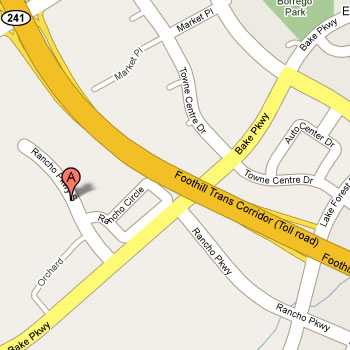IRONMAN FLORIDA RACE REPORT
Stuart Lowndes
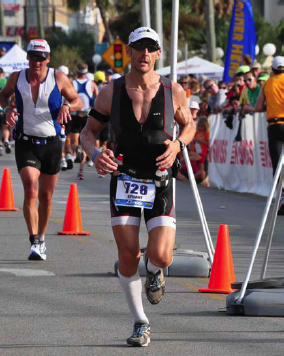 What an amazing experience the Ironman was, every emotion possible in the space of 9 ½ hours. The human body is unbelievable.
What an amazing experience the Ironman was, every emotion possible in the space of 9 ½ hours. The human body is unbelievable.
Starting from the swim, or should I say the open water kickboxing free for all, I got nailed in the face within the first minute. It was windy and the waves were about one-two feet high. Does not sound like much, but when you are trying to get through it with 2200 of your closest friends, it is a big deal. The entire way around was a fistfight and the women were the worst! Each corner you came to looked like a feeding frenzy for sharks, nothing but white water with arms legs and heads franticly trying to find open water. Everyone squeezed in to get as close to the buoy as they could.
After the first half I expected it to get better but it did not, so I walked with most of the others to the next buoy, as the water was only 2 feet deep. I probably lost a minute but it was a reprieve from getting kicked in the face, grabbed by the legs, or pushed down into the water by someone trying to swim over the top of you.
The second round was somewhat easier, but still a fistfight. I got my stroke together and relaxed more on the second round. Not sure what the spit was, but I would be confident the second half was faster. Exiting the water was a great feeling. Not only to get out of the fight, but to get to my favorite part of the race, the bike.
My transition was slow, as I have never used the ‘bags” for transition before. I am used to running up and seeing everything laid out for me on the towel, so it took a minute to get used to that. Once the head clicked into gear I was fine. It is great to have your own helper sitting with you, unpacking and packing your bag so you don’t have to worry about anything.
The bike felt great, as I knew it would. This course is somewhat flat, but there was a
15 mph wind from the east and there were some rolling hills to contend with. I followed my plan and took the first 10 minutes to get the heart rate down and relax into a groove. I hovered at 120 bpm and held it there; this is about 70% for me. Once out on the main portion of the course it was obvious this was going to be a “draft fest.”
Everyone was packed into the course so it was difficult to find some clear road. At one point I was in a pace line doing around 30mph, passing another pace line doing 27 mph with marshals riding along side waiting to ‘book you’ with a four minute penalty. I tried to keep the seven meters distance between bikes and managed for most of the way, however as soon as you came to a hill everyone bunched up. It was tough.
To be true to myself I decided that I would head to the front of the pack as often as I could and make sure I was working hard (85-90% HR) and then decided to nail the last 22 miles of the bike leg completely on my own. I bridged around ½ mile between groups, riding at 28mph totally on my own. Not very clever given this was an Ironman, but the HR was staying around 85% so I felt good.
There were a lot of crashes on the course; my thoughts go out to all the people I saw crash or heard crash (yes, you can hear a disk wheel hitting the floor hard from a few hundred yards away, even if it is behind you). There were some nasty situations. Warning to all first timers (as I was) these normally happen at the aid stations, so keep far right it you are not wanting aid and if you do need aid, keep your eyes in front as much as you can.
The bike, although enjoyable, was a long, long leg. Four hours and 44 minutes was my time. I ate well, mixing every 15 minutes between Hammer Perpeteum and Power bar gels. I used between two-four Endurolytes every hour depending on how I was feeling. I don’t do solid food during a race, but I think I need to change this, as you will find out from the run.
So a funny side and slightly gross (not to anyone who has done an Ironman), but have you ever wondered what you do when you need to pee on the bike leg? Sure, you pull over and use the portaloo (Porta potty for the Americans)… yeah right. No, you pee on the bike as you are riding. Well, this has challenges, one is that this is not something you really practice while out for the Saturday morning ride with friends. Not sure what the guys and girls would think of this.
So I talked to people on the course that had obviously emptied their bladders. “Pour a bottle of water on yourself” was one guy’s solution, works for him but not for me. “Stop pedaling and crouch down” was another suggestion, but again did not work for me. So I ended up not taking a leak for the entire bike (count also the wait time on the beach and the swim, so probably six plus hours. My second transition time was extended by at least two minutes from the break I took as soon as I walked in.
I have to thank Edge Cycle Sports of Lake Forest, CA for their support with the bike and wheels, a great setup by Hank and the team there. It is a great Bike / Tri shop as well for setup, sales and service with a world of knowledge on bikes. www.Edgecyclesports.net
Coming back into transition was bitter sweet, the bike had ended, but I had a great time and I was excited to start the run. The run started easy, Tim Monk (a fellow racer who qualified and raced in Kona this year, and an inspiration to me) said, “if the legs have spring in them at the start of the run you should be good.” Well the legs did feel good. I ran the first six miles at 126 – 130 bpm at an indicated pace of 6:40-7:20 (on my Polar).
I talked with a guy at the six-mile mark who said, “13 miles is the key, get to there and then get ready for trouble.” I focused on 13 miles to show it who was the boss. Passing 13 felt good, I was still holding the same good pace and felt as though I would be able to hold this the entire way. At the turn around point I saw the family and Rick / Kelly, great feeling to see someone you know cheering for you.
As I made the turn, Casey from The Woodlands came sprinting up to me. He was starting his first loop and this was a welcome break for me to talk with him although I was not the most talkative due to the focus on getting through the race. I have to
thank Casey for doing that; he did not need to sprint up to me at the start of his run as he did. This could not have helped his overall run.
As I forged ahead I could sense a familiar feeling in my guts. I always seem to have problems with ‘the guts’ when I run, but I managed to get to about mile 18 I think before I had to sprint into the portaloo on the run, I spent six minutes in there, not good. As I started my run again I could feel the stiffness that was not there six minutes before in the legs, especially the hamstrings.
In my times I can see I lost four-five minutes in the third segment of the run because as I continued running at 130 bmp and 7:20 – 7:50 pace, the hamstrings started to cramp at mile 19 as I entered the state park for the second time. Not good news, but if this was easy, everyone would be doing it.
My father in law, Mac, had died earlier this year. Sadly, as he was a fantastic bloke, I had the body-marker write ‘4 Mac’ on my right calf when they were putting my number on in the morning. I talked with Mac a lot during the next seven miles. He found some athletes in the sky and massaged my hamstrings for me every time they needed it. I did not stop to stretch; he had my back. Thanks Mac.
I promised the body I would walk very aid station for the run home, and this worked. Small goals were good for me. My ankles started to cramp, leading to my toes curling up on every foot strike, I felt good however apart from this. When I was running I was holding 7:30 pace with 130 bpm.
Another quicker bathroom stop was called for, not too bad this time though. I noticed three guys around me in my age group. Two of them had been on the bike with me, Roman and Pierre. Roman had a guy on a bike riding with him the entire way on the run, helping him hold pace (Cheating). Every time I walked the aid station he would get away, but by the time I reached the next aid station to walk again, I would catch him and Pierre. The last aid station was ½ mile from the finish, so do I walk? Or do I run? I promised the body I would walk every aid station so I did.
I took my time; coke and water intake was good. The last ½ mile I ran under six minute pace. As I came close to seeing the finishing area, maybe about ¼ mile, I ramped it up. I had already passed Pierre as he was huffing and puffing, Roman was ahead. I went passed him as though he was standing still and the run down the finishing chute was a full on sprint. I passed the third guy beating him by one second on the line (Sorry). Amazing what adrenaline does for you.
That was it, done!
Thanks to Kevin, an unsuspecting volunteer who then spent the next two minutes holding me up while I got my balance, breath and vision back. The plan was then to go get drunk like I do after most other races, this was different though. The body takes so much abuse that it simply shuts down. I was shivering, felt nauseous, felt as though the ground was moving around under me, and I still had severe ‘issues’. We did manage to get to Harpoon Henry’s for chicken wings, a big fat burger WITH bacon and cheese and a margarita. I managed two wings, ¼ of the burger and only ½ the margarita. Walking to get the bike was tough, as I collected my stuff and headed to the car.
I have spent all night sweating like a dog and wide-awake. It felt like the Flu, as the body was busy trying to repair whatever it could. I think I slept two hours maybe, drank a carton of Orange juice and hallucinated all sorts of weird stuff. Would I change this? No way, it was all worth it!
The morning after was a new day. I feel great, had a big fat IHOP breakfast and then off to the race site to buy all the ‘Panama City Ironman Finisher’ clothing and gear I could get my hands on! Not sure about a roll down slot to Kona, not sure I even want to do it right now, but I will go hang out and see anyway. My decision I think is still ‘No’.
Lastly, thanks to my wife and kids for putting up with the craziness that has been
Ironman training, and everyone else around me for either their support or the extra help to make sure I can hit my goals; especially at work, you know who you are!
What next? Not another Ironman in 2010, I can tell you that! I need to hit some anaerobic workouts as all of this aerobic work has slowed me down. I plan to race local quarters with a view to getting on the Podium, also hitting the 70.3 IM (Half Ironman) course to try to qualify for the World Championships for that distance which is in Clearwater, FL next November. “Stuart Lowndes, you are an Ironman,” sounded great.
Some statistics from my race and training:
There were 2423 people started the race, 2328 finished. There were 1300 Ironman
‘Virgins’ including me. I came 66th overall, 45th if you take out the professionals that were above me. I beat 13 of the Male Pro’s. I was 19th in my age group out of 385 finishers.
In the swim I came 277th overall, all of the Pro’s beat me. I was 54th in my age group out of 385 finishers.
On the bike I came fifth in my age out of 385 finishers (I think that deserves a new bike). I was 31st overall out of the 2328 finishers; only 14 of the Pro’s beat me on the bike! Not bad for a Quintanaroo Seduza with Dura Ace gear.
On the run, even with my ‘issues’ I came 29th in my age group with a 3hr 28-minute marathon, good even without the swim and bike! I was also 98th overall including the Pros.
Over 28 weeks I swam a total of 243,410 yards or 138 miles, I biked a total of 3,853 miles and ran a total of 803 miles. During this time I burned 270,575 calories, or the equivalent of 68lbs in weight. I ate an estimated 700 Powerbar gels and over 200 Powerbars.
USING NUTRITION TO OPTIMIZE RECOVERY
Kristy Richardson
Did you know that adjusting the timing and nutrient composition of your after workout meals can increase your energy, enhance your ability to gain muscle mass and improve your performance in subsequent workouts?
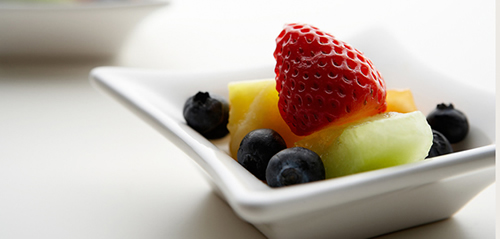
The two-hour window
Your body has an enhanced ability to replenish muscle glycogen stores (one of your main fuel sources during workouts) and repair muscle tissue during the two hours following a workout. In order to optimize recovery, make sure to consume a recovery snack within 30 minutes of your workout and a real meal within two hours. The recovery snack and real meal should include carbohydrates and protein.
When choosing drinks, bars or other recovery foods, look for a 3:1 or 4:1 ratio of carbohydrate to protein. Here are a few recovery recommendations for drinks, bars and other foods.
Recovery drinks
• Low fat milk, chocolate milk or soymilk
• Recovery shake made with milk/yogurt, fruit & 1 scoop of whey protein
• Light Muscle Milk with a banana
• Endurox R4
• P90X Recovery Drink
Recovery bars
• Kashi Go Lean
• Luna
• Powerbar Harvest
• Clif Bars
• Balance or Zone Bar with fruit
Other convenient recovery foods
• Low fat yogurt or cottage cheese & fruit
• Sandwich containing lean meats or peanut butter
• Lean Ole’ frozen burrito from Costco
• BRC burrito from El Pollo Loco
Recovery nutrition is most important following:
• Intense aerobic workouts longer than 90 minutes with less than 24 hours of recovery
• Intense resistance training
This information was brought to you by OC Nutrition, your trusted source for health & nutrition advice. OC Nutrition offers nutrition counseling services for Triathica. If you have any questions or would like to schedule an appointment, please contact:
Kristy L. Richardson, MS, MPH, RD, CSSD, CHES
Registered Dietitian & Exercise Physiologist
(949) 933-6788
kristy@ocnutrition.com
www.ocnutrition.com
YOUR “A” RACE
Ron Saetermoe
 Of course every race we enter is important and we want to do well in it, but there is one key race (maybe two) every season that is your “A” race (most important). That’s the race you hope to do your best at. Other races can be classified as “B” (important) or “C” (less important), but your “A” race is the big daddy of the season.
Of course every race we enter is important and we want to do well in it, but there is one key race (maybe two) every season that is your “A” race (most important). That’s the race you hope to do your best at. Other races can be classified as “B” (important) or “C” (less important), but your “A” race is the big daddy of the season.
For me this year it’s Ironman Arizona coming up on Sunday, November 22nd. This is the race I’ve been training the last year for. You see, I did IMAZ in 2008 and completely bonked on the run. So this year I’m hoping to improve my performance by over an hour. We’ll see . . .
To be honest, I’m nervous about it. How can you possibly work so hard for something, and not be? Since I was there last year, I know the course very well so I’ve pictured the perfect race in my head hundreds of times. No one has a “perfect” race (other than in their head) but it’s certainly something we aspire to.
Getting ready for your “A” race is no small task. I put my training plan together last year, which can be a very time consuming process (if you even know how to do it) in itself. Then, you’ve got to do all the actual work!
Fortunately I’m much healthier this year than last and I’ve had some good race results as well. I think I’ve got my nutrition dialed in so I’m ready to rock!
You should carefully consider what your “A” race will be next season as well. This isn’t too late for you to be setting your race schedule for next year. Many races sell out amazingly fast. I was told, for example, that Ironman Florida was sold out the day after the event (that’s 364 days before the race!). I know the California Ironman 70.3 has been sold out for months now.
The number of races you do is totally dependent on the time you have to train and race as well as your budget. No one said triathlon was going to be cheap! But it really doesn’t matter how many races you do, plan them out, designate your “A” race and work toward that goal.
Cheers!
FREE GROUP WORKOUTS (Week of November 9th)
All of our group workouts are free to members and non-members, so come on out (Pool entry is $2.50)!
We want everyone to enjoy our group workouts but we should clarify the intent. The intent of the group workouts is to “workout.” Yes, it includes a social element. Yes, your Triathica host is happy to give you tips. But please be aware that everyone there is attempting to get a workout in at his or her own pace. If we all go at the slowest person’s pace many people won’t be getting in a proper workout. We will attempt to pair you up with another athlete so you’re not left alone.
Week of November 9th
Event: Group Swim
Place: Crown Valley Community Pool in Laguna Niguel (Next to the YMCA; $2.50 entry fee)
Day: Wednesday, November 11th
Time: 6:00 p.m. (Pool closes at 8:00 p.m.)
Planned Workout: Individual preference
Event: Group Ride
Place: Triathica HQ
Day: Saturday, November 14th
Time: 7:00 a.m.
Planned Workout: Santiago Canyon Loop
Event: Group Run
Place: Triathica HQ
Day: Sunday, November 15th
Time: 7:00 a.m.
Planned Workout: Whiting Ranch Loop
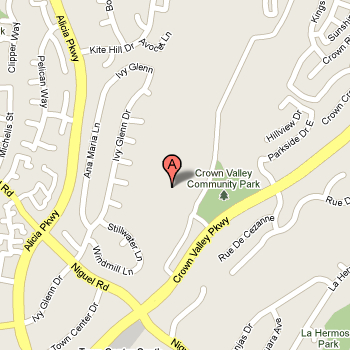 |
Crown Valley Community Pool – Laguna Niguel From the 5 North take the exit 86 for Crown Valley Pkwy. Turn right at Crown Valley Pkwy and drive about 3 mile. The pool will be on the right. |
TIPS FOR THE TRIATHLON TRAINING DIET
Alyson Wolfe
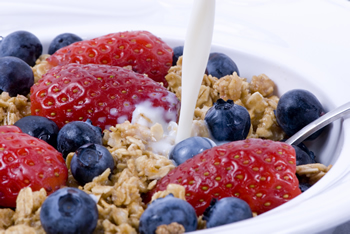 Getting the proper nutrition before an event is an important aspect of your triathlon training. Proper nutrition before, during and after an event will help you prepare, compete and recover from your competition. Focusing on your triathlon nutrition and planning your meals is a great way to provide confidence in knowing that you have the best possible nutritional preparation before an event.
Getting the proper nutrition before an event is an important aspect of your triathlon training. Proper nutrition before, during and after an event will help you prepare, compete and recover from your competition. Focusing on your triathlon nutrition and planning your meals is a great way to provide confidence in knowing that you have the best possible nutritional preparation before an event.
Planning out your diet during triathlon training can help ensure you are meeting your body’s increased nutrient requirements. When designing your nutritional plan for training, you can individualize your plan based on your personal training levels. The increased nutrient requirements will depend on your training volumes, frequency and intensity. Your requirements will also vary during the different training phases of the year.
Some basic guidelines that will help you meet a triathlon training diet are:
1. Eat a variety of food from each of the four major food groups each day. Make sure you stick with breads and cereals, vegetables and fruits, milk, and dairy products, and lean meats like poultry, fish, eggs, nuts and/or meat substitutes like lentils, chickpeas, soy beans and other beans. Processed foods should be avoided as much as possible.
2. If you must choose pre-prepared foods, drinks and snacks, pick those that are low in fat (especially saturated fat) and salt.
3. Drink plenty of fluids each day.
4. Supplements are not the answer! Often when triathletes reach for supplements they choose supplements that are not appropriate for their needs. Triathletes sometimes forget that the nutrients they try to get from supplements have been scientifically proven to be more beneficial when found in its natural form in food. Anything you get in a supplement can be found in food. Supplements are just more convenient sometimes, but not necessarily more effective.
5. Get enough vitamins and minerals: Vitamins B, C, and E as well as adequate amounts of Iron, calcium and zinc, these are all key to a healthy training diet.
Remember that the above are general nutrition guidelines that provide the foundation for a healthy diet. A triathlete should eat a wide variety from each of the food groups to ensure they are getting the nutrients the body needs. In doing this, you will also have more of a variety in meals.
The optimal diet for peak performance will vary with the athlete just like training must vary from person to person. Everyone cannot eat the same thing and get the same results. The bottom line is that you must discover what verity works for you and your bodies’ needs. Experiment and don’t assume that you have found the only combination that works for you. Sometimes a small change can make a big difference.


